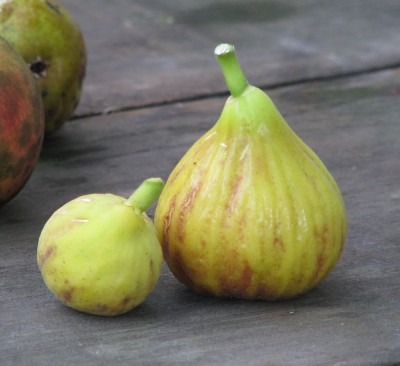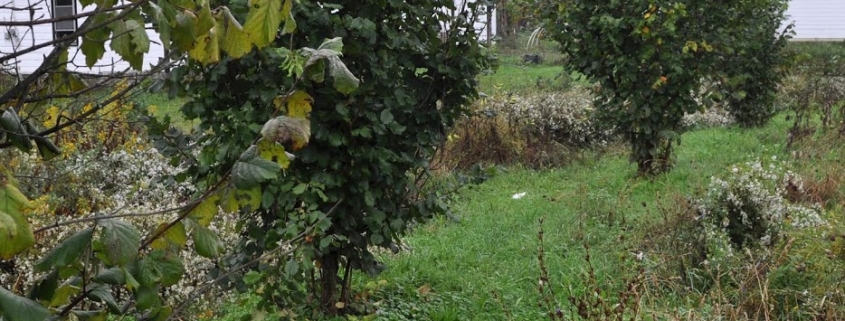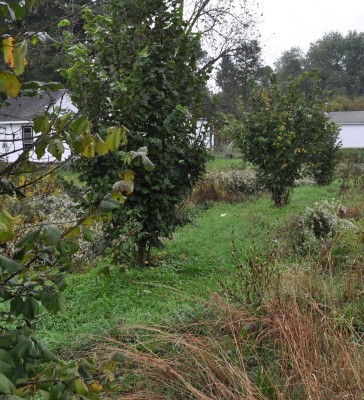SQUIRREL BATTLES BUT FIGS ARE FINE
It’s a tied score, 1 for the squirrels, 1 for me. At least since I started counting, which was last year. I had some squirrel issues in previous years, but last year is when all out war started. They cleaned out the raspberries and the gooseberries early in the season, and then started eyeing the blueberries. Anyone who reads “A Gardener’s Notebook” knows how I feel about blueberries, and the squirrels evidently picked up those vibes (with some ballistic coaxing) and left the blueberries alone. Not that they kept to their nearby forest homes; they scurried across the field in late summer to strip the hazelnut bushes of every single nut.
This year is different, very different. The squirrels didn’t eat even one raspberry or gooseberry, didn’t even eye the blueberries. And my harvest of hazelnuts is secure in bushel baskets.
In fact, I only saw a couple of squirrels the whole season. They were two young ones gamboling in the tree tops, taunting me in full view from the back window of my bedroom.
A multifaceted approach is responsible for this year’s victory. Two excellent cats are one line of defense, although I can’t imagine how cats could keep squirrels at bay. Perhaps the squirrels also saw me practicing my marksmanship. And finally, I let the field in which I planted the hazelnuts grow up into an overgrown meadow. I’ve never seen squirrels in high grass and other herbaceous vegetation, probably because it slows them down too much. (Then again, perhaps I’ve never seen squirrels in unmown meadow because I can’t see them in unmown meadow.)
To reduce competition for water and nutrients to the hazelnut plants from the meadow, I kept vegetation scythed down in a circle around each hazelnut bush and accessed the plants via a mowed path that originates only 50 feet across mowed lawn from my deck. My two dogs, Leila and Scooter, spend a lot of time sleeping on that sunny deck, so it would take a bold squirrel indeed to make the journey across the lawn and then down that no-exit, mowed path in overgrown meadow.
————————————————
As for anyone who pooh-poohs my obsession with squirrels, mark my words: In a few years you’ll consider them much, much worse problems than deer. Some people tell me that squirrels are even eating their tomatoes. Fencing is, obviously, useless against squirrels.
Squirrels have never eaten my tomatoes. I’ve never even seen them in my vegetable gardens although black walnut seedlings that sometimes pop up here and there are evidence of their occasional trespass.
I wonder if squirrels eat lettuce; I hope not, because I have some nice heads developing in the garden and in seed flats. This is the time of year that takes advance planning with lettuce because, although the plants enjoy the cooler weather, it, along with shorter days, drastically slows growth.
I aim to grow enough lettuce for salads all winter so must have enough plants started to slowly mature in the weeks and months ahead. If the plants are too small, they won’t size up when it’s their turn to be eaten. If the plants are too large, they bolt, that is, make seedstalks and turn bitter. Right now, I have two rows of mature heads in the garden and over 150 seedlings of various sizes. All those seedlings take up only about 4 square feet of space. The smaller seedlings will get transplanted into the greenhouse sometime soon.
———————————————–
Greenhouse lettuce can tolerate a little shade right now, but not in a few weeks. That works out perfectly, because right now the greenhouse is shaded by 3 large fig trees growing within. They are three different varieties, each loaded with fruit.
Kadota is the best-tasting of the three, with a sweet, rich flavor held in a chewy skin. The problem is that Kadota likes dry weather, as do all figs, to some degree. With the current humid weather and incessant rain, many of the Kadota fruits rot just as they are about to ripen.
 My old standby, Brown Turkey, sweet, small, and dark purple, does better. The tree has been ripening fruits since about early September.
My old standby, Brown Turkey, sweet, small, and dark purple, does better. The tree has been ripening fruits since about early September.The best of the lot, in terms of flavor (not as good as Kadota but, still, very good) is Green Ischia, also known as Verte. This variety bears fruits on stems that grew last year as well as, like my other two varieties, stems that started growing this year. Green Ischia’s earliest figs ripen in July on last year’s stems, followed by more fruits, beginning in September, on this year’ stems. The figs are sweet and very large and juicy, so much so that they begin to burst open if harvest is delayed too long. My Green Ischia, by the way, is probably not Green Ischia; figs are notorious for having multiple names and for being mislabeled, as I think mine was in the nursery.
The fig crop will end in a few weeks, the plants’ leaves will fall, and I’ll cut back all stems, except for a few on Green Ischia for next year’s early crop, down to about 4 feet high. Greenhouse lettuce can then bask freely in whatever sunlight autumn and winter sun offers.







I’d like to know more about light in greenhouses: whether plants get enough to be healthy to eat? I recall reading something years back about a project in Woods Hole that indicated that too many nitrates were in the lettuce. Please advise.
I remember reading about such research. I haven’t tested my lettuces for nitrates but use only compost or compost plus soybean meal for feeding the soil. This type of feeding should not lead to high nitrate levels in the soil or, hence, the plants because nitrogen is released from the compost or soy at a slow rate in response to heat and moisture. Plants also grow in response to heat and moisture so are in synch pretty much with nitrogen mineralization, unless slowed to much by low light. My greenhouse stays pretty cold in winter. Still, I am now going to consider measuring soil or plant nitrate levels.
Thanks very much for your acknowledge met concerning this issue. Please let me know your findings. The most recent research I came across(years ago) focused on the effects of light levels. I’m wondering if maybe there’s newer research done in Europe, where greenhouses are in extensive use in some areas,for crop growing. I imagine it’s less of an issue the more Winter light is available,as in Mediterranean areas, but perhaps a greater concern where less light occurs. Eliot Coleman emphasizes the amount of sun available in the Winter in Maine, which has a similar latitude as southern France. Here in Vermont, there’s even a question of how much Vitamin D we can get, due perhaps to the effect of the mountains. I’m referring to Vitamin D from the sun. Anyway, this is a question I’ve been pondering for awhile without finding much information. Haven’t actually tried in last few years, will look on I-pad.
I am going to make a note to myself to test for nitrate in soil and/or plants in February. If I remember correctly, the studies to which you were referring were with spinach; it would be interesting to note if that was the case with other leafy greens also. I grow mostly lettuce and mache in winter.
As far as sunlight, Elliot’s latitude is 44°48″; Nice, France, on the Mediterranean, is 43°42″. So light differences are not significant from you or Elliot and SOUTHERN France. I’m at 42°. I wouldn’t think Vermont’s mountains high enough to affect insolation. My guess is that cloud cover and humidity is more significant.
I got an idea from watching “Homested Rescue” from Misty. She was referring to protecting strawberries but when I applied the concept to me fig tree, IT WORKED! Paint some rocks that are the size of figs the color of ripe figs — brown in my case, and hang them using small wire all over the fig tree branches. when the squirrels try to steel them for a snack, they can’t eat them. after a couple of days of bitting rocks, they stop going to the tree and you have ended your issue with squirrels!
Thanks Misty
I’ve heard of people using that for strawberries and birds. I find it hard to believe it would work for squirrels since they are quite clever.
It doesn’t work. They can smell and feel the difference the same as the chickens can. I despise tree rats. Now that the figs trees are coming ripe, squirrels are coming from everywhere. They’re fighting each other and fighting my chickens – over figs.
Things that were a considerable waste of money and had zero results: traps, bait, netting, spraying the trees with capsaicin, several “commercial repellents”, cats, dogs.
What finally worked: dollar store peanut butter and a rifle.
Not sure which thing you’re referring to as “it” doesn’t work. The high grass meadow has kept squirrels at bay. I agree with wasted money on special baits. I’m surprised the capsaicin spray didn’t work. It’s good for nuts because we humans don’t eat the shell.
Well the post captured my attention because last year and this I have had a major squirrel issue with my figs. The juerks ate both harvests last year and the first this year. The second crop is coming on and I caught a squirrel there yesterday, and this evening his friend, a mouse! Thankfully they leave everything else alone, including an amazing harvest from our plum which literally overhangs the fig. Any ideas?
Squirrels are one of the hardest to control garden pests. I keep them at bay with traps, outdoor dogs, and occasional injections with lead. I’m surprised they haven’t gotten to your plums. They often eat stone fruit when fruits are still young and green.